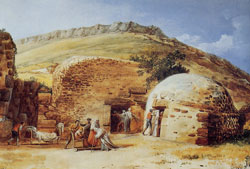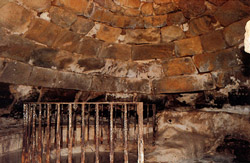
Lipari. The thermal complex of San Calogero
The thermal springs of the island of Lipari, recorded by writers of the Greek and Roman periods, were so famous that one of the minor thermal establishments in Rome bore the name of Eolia.
There is no doubt that these classical citations of Lipari refer in particular to the hot spring of San Calogero, on the western side of the island, to which a carriageway now descends from Piano Conte.
The building over the spring is a pseudo-domed chamber, of the kind known as a tholos, roofed by a corbelled vault constructed with superimposed concentric rows of blocks in isodomic courses, the one projecting slightly over the other, and hence with a gradually diminishing diameter from bottom to top. The blocks are perfectly smoothed on the inside, but only rough-hewn on the rear side, given that the tholos, set into the hillside, was largely invisible from the outside.
This is a type of structure characteristic of Mycenaean architecture. Its small dimensions are in evident relation to the function itself of the bath-house for which it was built. Trial excavations conducted by Bernabò Brea and Cavalier in 1985, both on the inside and outside of the building, seem to confirm this opinion, already deducible from structural examination of the monument.
Bibliography:
- L. Bernabò Brea M. Cavalier, La tholos termale di San Calogero nell'isola di Lipari, Studi Micenei ed Egeo-Anatolici, 1991, pp. 1-78.

